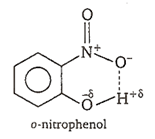 Multiple Choice Questions
Multiple Choice QuestionsTwo vessels of volumes 16.4 L and 5 L contains two ideal gases of molecular existence at the respective temperature of 27°C and 227°C and exert 1.5 and 4.1 atm, respectively. The ratio of the number of molecules of the former to that of the later is
2
1
When 4 g of an ideal gas A is introduced into an evacuated flask kept at 25°C, the pressure is found to be one atmosphere. If 6 g of another ideal gas B is then added to the same flask, the pressure becomes 2 atm at the same temperature. The ratio of molecular weight (MA : MB) of the two gases would be
1 : 2
2 : 1
2 : 3
3 : 2
Identify an extensive property amongst the following.
Viscosity
Heat capacity
Density
Surface tension
Intramolecular hydrogen bond is present in
water
o-nitrophenol
p-nitrophenol
methylamine
B.
o-nitrophenol
The hydrogen bonding which takes place within a molecule itself is called intramolecular hydrogen bonding. It takes place in compounds containing two groups such that one group contains a H-atom linked to an electronegative atom and other group contains a highly electronegative atom linked to a lesser electronegative atom.

56 g of nitrogen and 96 g of oxygen are mixed isothermally and at a total pressure of 10 atm. The partial pressures of oxygen and nitrogen (in atm) are respectively
6,4
4,6
5,5
2,8
Hydration of different ions in aqueous solution is an example of
ion-dipole interaction
ion-induced dipole interaction
dipole-dipole interaction
dipole-induced dipole interaction
When a sample of gas is compressed at constant temperature from 15 atm to 60 atm, its volume changes from 76 cm3 to 20.50 m3. Which of the following statements are possible explanations of this behaviour ?
1.The gas behaves non-ideally
2. The gas dimerises
3. The gas is adsorbed into the vessel walls
1, 2 and 3
1 and 2 only
2 and 3 only
1 only
The vapour pressure of two liquids X and Y are 80 and 60 Torr respectively. The total vapour pressure of the ideal solution obtained by mixing 3 moles of X and 2 moles of Y would be
68 Torr
140 Torr
48 Torr
72 Torr
Two liquids X and Y form an ideal solution. The mixture has a vapour pressure of 400 mm at 300 K when mixed in the molar ratio of 1 : 1 and a vapour pressure of 350 mm when mixed in the molar ratio of 1 : 2 at the same temperature. The vapour pressures of the two pure liquids X and Y respectively are
550 mm, 250 mm
350 mm, 450 mm
350 mm, 700 mm
500 mm, 500 mm
